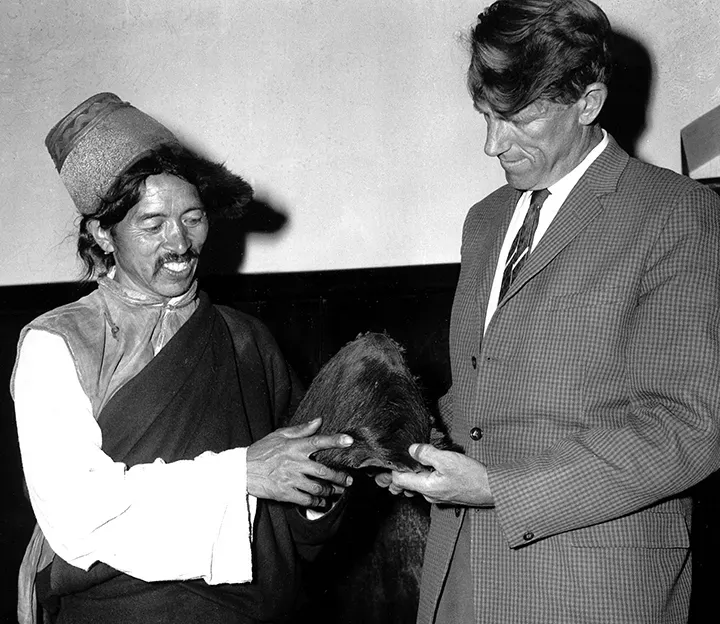The Yeti Exists in the Himalayas: Myth or Reality?
Explore the enigma of the Yeti in the Himalayas. Delve into folklore, sightings, and scientific pursuits surrounding this elusive creature, blending myth with reality.

The world is filled with captivating mysteries and legendary creatures that continue to capture our imagination. Among them, the Yeti, also known as the Abominable Snowman, stands as one of the most intriguing and elusive beings in folklore and cryptozoology. For centuries, stories and sightings of this creature have fascinated adventurers, scientists, and enthusiasts alike, fueling expeditions to the remote and treacherous regions of the Himalayas. Today we embark on a captivating journey to uncover the truth behind the Yeti, delving into the realms of mythology, scientific investigations, eyewitness accounts, and the enduring allure of this cryptid.
Introduction
A mythical creature that has captivated imaginations for decades. This enigmatic being, believed to reside in the vast Himalayan ranges of Nepal and Tibet, remains a source of fascination and debate. Derived from the Nepali dictionary, the term "Yeti" is synonymous with the intriguing moniker "abominable snowman." In the folklore of Tibet, it is known by the name "Meh-Teh." The Yeti is often depicted as a white, shaggy creature resembling an ape, standing on two legs and reaching extraordinary heights of 10 to 20 feet.

Recently, this intrigue was reignited when the Indian Army announced the discovery of fresh, puzzling footprints during an expedition to Mount Makalu, adding another intriguing chapter to the enduring saga of the Yeti.Remarkably, the footprints uncovered by the Army measured an impressive 32x15 inches, clearly distinguishing them from human footprints and further fueling the mystery surrounding this elusive creature.
Encounter with the Yeti

1921
The earliest recorded encounter with the Yeti dates back to 1921, when renowned British explorer Charles Howard-Bury made a remarkable discovery during his expedition in the Himalayas. In his book "Mount Everest: The Reconnaissance, 1921," Howard-Bury recounts stumbling upon perplexing footprints near Lakhpa La pass. What he found amidst the animal tracks were the imprints of a humanoid creature, resembling that of a human. Curiosity piqued, Howard-Bury later learned from the locals about the ancient legend surrounding a tribe of untamed, hairy beings inhabiting the most remote and inaccessible peaks of the mountains. This significant account serves as an enduring testament to the enduring allure and mysterious nature of the Yeti.

1951
In 1951, the esteemed English Himalayan explorer Eric Shipton made a captivating discovery as he documented footprints believed to be left by the elusive Yeti. What made these footprints truly intriguing was the presence of a distinctive thumb-like impression instead of a typical toe. Not long after,

1960
In 1960, Sir Edmund Hillary made headlines when he returned with what he initially believed to be the scalp of the Yeti, resembling a helmet. However, subsequent analysis revealed that the scalp actually belonged to a serow, a goat-like animal.

2010
The search for the Yeti continued to present intriguing encounters and subsequent debunking. In 2010, Chinese hunters claimed to have captured a hairless, four-legged creature that they believed to be the legendary Yeti. However, further examination confirmed that it was, in fact, a civet that had lost its hair due to a disease.

2011
In 2011, researchers made headlines with their alleged discovery of a Yeti finger, only to have the DNA analysis reveal that it belonged to a human.
As the years passed, the fascination with the Yeti persisted. In 2013, the renowned National Geographic released a captivating documentary exploring the legend of the Yeti in the Himalayas, shedding light on the enduring allure and mystery surrounding this mythical creature. These encounters, discoveries, and subsequent revelations serve as a testament to the ongoing quest for truth and understanding of the enigmatic Yeti.
Sherpa and Yeti
The Sherpa people, an ethnic group from eastern Nepal, live in the rugged Himalayan highlands at altitudes averaging 12,000 feet. Renowned for their exceptional mountaineering skills and deep knowledge of the local terrain, they are integral to Himalayan expeditions, often serving as guides and porters. In addition to their mountaineering expertise, the Sherpa culture is rich in traditions and deeply connected to their Tibetan Buddhist beliefs, which shape their daily lives and worldview.
In Sherpa folklore, the Yeti, a legendary and elusive creature, plays a significant role. This creature is often portrayed as formidable and unpredictable, deeply woven into the tapestry of their cultural stories and beliefs. One common tale among the Sherpas describes how the Yeti would stealthily block the entrances to homes in their villages, particularly when men, who are often away for long periods due to mountaineering expeditions, are absent. This action by the Yeti creates a sense of dread and unease among the villagers.
Another story tells of a time when humans attempted to manipulate the Yetis, tricking them into conflict with each other. However, this plan disastrously backfired. Instead of turning on one another, the Yetis united in their anger, vowing to seek revenge against humanity. These narratives not only highlight the Sherpas' beliefs in supernatural elements but also reflect their respect and caution towards the natural and unknown aspects of their harsh, mountainous environment.
Tale of the Sherpas
It is worth noting that the lore surrounding the Yeti includes the existence of female counterparts. In one particular story, a female Yeti captured a man with whom she bore two children. However, when the man managed to escape with their son, the female Yeti resorted to a tragic act, killing and consuming her own daughter. These tales depict the complex and sometimes dark nature attributed to the Yeti in traditional folklore.
Folktales featuring the Yeti may have served as cautionary tales or, more likely, as moral lessons to ensure that children would not stray too far from their communities. By sharing these stories, the intention may have been to emphasize the importance of staying close and secure within the community, thereby ensuring the safety and well-being of the children.
Conclusion
The quest for the Yeti continues to evolve in the modern era. We delve into recent sightings, expeditions, and scientific advancements that shed new light on the creature's existence. We explore the use of advanced technology such as drones, thermal imaging, and DNA analysis in the search for definitive proof. Moreover, we discuss how conservation efforts in the Himalayas and the preservation of its biodiversity are intertwined with the pursuit of the Yeti, highlighting the delicate balance between mythology, science, and the natural world.
Even without concrete evidence of its existence, the Yeti has managed to capture the imagination of people, becoming a prominent figure in folklore and animated entertainment. From beloved characters like Tintin and Scooby-Doo to animated films like Monsters Inc, the Yeti has been reimagined numerous times, leaving an indelible mark on popular culture.
The Yeti, existing within the world of mysterious creatures and legends, captivates the minds of adventurers, scientists, and enthusiasts. As we explore tales, sightings, scientific inquiries, hoaxes, and modern expeditions, we find ourselves at a junction where belief and skepticism meet. Although the truth about the Yeti remains elusive, our pursuit of knowledge, the preservation of culture, and our unwavering curiosity continue to drive us in our quest for this elusive Abominable Snowman.
As we conclude our journey through the shadowed valleys and snow-capped peaks of the Himalayas, the legend of the Yeti remains an enigmatic tapestry woven from folklore, sightings, and the quests of the curious. In the heart of these mountains, the line between myth and reality blurs, leaving us with more questions than answers.
Whether the Yeti is a creature of flesh and bone, or simply a phantom born from the depths of our imagination, its story continues to captivate and inspire. It stands as a symbol of the unknown, a reminder of the mysteries that still linger in the unexplored corners of our world.
FAQ
Why do they call it the Abominable Snowman?
British explorers reported seeing the creature during an expedition. They used the term metoh-kangmi or "man-bear snowman," but the metoh was mistranslated by a journalist as "filthy" and later changed to "abominable". The term "Abominable Snowman" stuck and remained associated with the mythical creature.
Is the Yeti a myth or fact?
The legends of the Yeti originated in the folklore of the ancestors of the Himalayan people. Over the years, there have been numerous reports, sightings, and evidence claiming to prove its existence. However, DNA tests have repeated proven that findings are actually either wild or domestic animal or human remains. The Yeti remains a cryptid creature, not recognized by science.
What are the theories of the Yeti?
The Yeti comes from the folklore of the ancient Himalayan people. Since then, many have speculated about what the Yeti could be and where this mythical creature originated. Some have speculated that it is a surviving hominid, or ancestor of the human race. DNA evidence has disproven any such links. The remains purported to be from a Yeti have proven to be either common animals or human in origin.
What cartoon is the Abominable Snowman?
Hugo the Abominable Snowman is a character in the Looney Tunes franchise.




